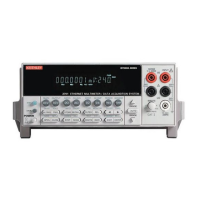2-32 Close/Open Switching Module Channels Model 2701 User’s Manual
SLOTX: 77XX — Use to scroll the closed channels and channel settings (if applicable)
for the switching module in Slot X (where X = 1 or 2).
Scrolling speed — The scrolling speed of the channel string is adjustable or can be
paused. The key slows down scrolling speed and the key speeds it up. The ENTER
key pauses scrolling. Press ENTER a second time to resume scrolling.
Exiting VIEW — To exit from VIEW, press the EXIT key. Pressing an instrument setting
key will also exit VIEW, but it will also perform the operation associated with the key. For
example, pressing Ω2 will exit VIEW and select the Ω2 function.
NOTE When a command is received while the display is scrolling, the instrument exits
from the CARD menu and the command is executed.
Switching module queries (remote operation)
For remote operation, there are commands to identify installed switching modules and
channels that are closed. There are also commands to acquire general information about
the installed modules.
*OPT?
For remote operation, the *OPT? command can be used to determine which switching
modules (or pseudocards) are installed in the Model 2701. For example, assume a
Model 7700 is installed in slot 1 and the other slot is empty. The following message is the
response message for the command:
7700, NONE
ROUTe:CLOSe?
ROUTe:MULTiple:CLOSe?
ROUTe:MULTiple:CLOSe:STATe? <clist>
These query commands are used to determine closed switching module channels.
ROUT:CLOS? is used to return a list of closed measurement channels including the paired
channel for 4-wire measurements. It will not return non-measurement channels. For
details, see Table 2-1 and related reference information.
ROUT:MULT:CLOS? is used to return all closed channels (measurement and non-
measurement). For details, see Table 2-2 and related reference information.
ROUT:MULT:CLOS:STAT? is used to return the state (open or closed) of each specified
channel. A “0” is returned for an open channel and a “1” is returned for a closed channel.
For details, see Table 2-2 and related reference information.

